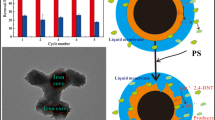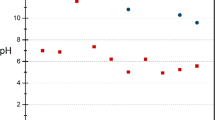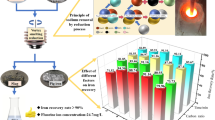Abstract
Remnant nuclear fuel debris in the damaged nuclear reactors at the Fukushima Daiichi Nuclear Power Plant (FDNPP) has contacted the groundwater containing microorganisms for over ten years. Herein, we report the possibility of bacterial alteration of fuel debris. We investigated the physical and chemical changes of fuel debris simulants (FDS) in the powder and pellet forms via exposure to two ubiquitous bacteria, Pseudomonas fluorescens and Bacillus subtilis, which are not recognized as metal element-oxidative (e.g., iron-oxidative) bacteria under aerobic conditions. In the experiments using FDS composed of the powders of Fe(0), solid solution of CeO2 and ZrO2, and SiO2, Ce, Zr, and Si were hardly dissolved, while Fe was dissolved, a fraction of the dissolved Fe was present in the liquid phase as Fe(II) and Fe(III), and the rest was precipitated as the nano-sized particles of iron (hydr)oxides. In the experiment using P. fluorescens and FDS pellet pieces prepared by melting the Fe(0) particles and solid solution of CeO2 and ZrO2, the bacteria selectively gathered on the Fe(0) particle surface and made corrosion pits. These results suggest that bacteria in groundwater corrode the iron in fuel debris at FDNPP, change fuel debris into porous one, releasing the nano-sized iron (hydr)oxide particles into the water.






Similar content being viewed by others
References
Kuwabara H, Overview of IRID's research and development activities. International Research Institute for Nuclear Decommissioning, https://irid.or.jp/_pdf/20160915.pdf. Accessed 2016 [in Japanese]
Agency for Natural Resources and Energy, METI, Current status of Fukushima Daiichi Nuclear Power Station - Efforts for decommissioning and contanimated water management. https://www.meti.go.jp/english/earthquake/nuclear/decommissioning/pdf/sum202004.pdf. Accessed 2020 [in Japanese]
Mccardell RK, Russell ML, Akers DW, Olsen CS (1990) Summary of Tmi-2 core sample examinations. Nucl Eng Des 118:441–449
Hofmann P, Hagen SJL, Schanz G, Skokan A (1989) Reactor core materials interactions at very high temperatures. Nucl Technol 87:327–333
Nagase F, Uetsuka H (2012) Thermal properties of three mile island Unit 2 core debris and simulated debris. J Nucl Sci Technol 49:96–102
Kitagaki T, Yano K, Ogino H, Washiya T (2017) Thermodynamic evaluation of the solidification phase of molten core-concrete under estimated Fukushima Daiichi nuclear power plant accident conditions. J Nucl Mater 486:206–215
Robb RK, Francis WM, Farmer TM, Enhanced Ex-Vessel Analysis for Fukushima Daiichi Unit 1: Melt Spreading and Core-Concrete Interaction Analyses with MELTSPREAD and CORQUENCH, Oka Ridge National Laboratory, https://info.ornl.gov/sites/publications/files/Pub39382.pdf . Accessed 2013
Sudo A, Mizusako F, Hoshino K, Sato T, Nagae Y, Kurata M (2019) Fundamental study on segregation behavior in U-Zr-Fe-O system during solidification process. Trans At Energy Soc Jap 18:111–118
Marui A, Gallardo AH (2015) Managing groundwater radioactive contamination at the Daiichi nuclear plant. Int J Env Res Pub He 12:8498–8503
IRID and TEPCO, Internal investigation of primary containment vessel in Unit 2. IRID, TEPCO, https://www.nsr.go.jp/data/000179411.pdf. Accessed 2017 [in Japanese]
Nagaoka University of Technology, Evaluation of radiation dose distribution in the plant and exploration of fuel debris in water, Project Nuclear Energy Science & Technology and Human Resource Development. https://www.kenkyu.jp/nuclear/field/h27/h29uk_1_1report.pdf. Accessed 2018 [in Japanese]
Pal S, Pradhan D, Das T, Sukla LB, Chaudhury GR (2010) Bioleaching of low-grade uranium ore using Acidithiobacillus ferrooxidans. Indian J Microbiol 50:70–75
Munoz JA, Gonzalez F, Blazquez ML, Ballester A (1995) A study of the bioleaching of a spanish uranium ore. 1. a review of the bacterial leaching in the treatment of uranium ores. Hydrometallurgy 38:39–57
Guay R, Silver M, Torma AE (1977) Ferrous iron oxidation and uranium extraction by thiobacillus-ferrooxidans. Biotechnol Bioeng 19:727–740
Ibars JR, Moreno DA, Ranninger C (1992) MIC of stainless steels: a technical review on the influence of microstructure. Int Biodeter Biodegr 29:343–355
Konhauser KO, Kappler A, Roden EE (2011) Iron in microbial metabolisms. Elements 7:89–93
Johnstone TC, Nolan EM (2015) Beyond iron: non-classical biological functions of bacterial siderophores. Dalton T 44:6320–6339
Bidle KD, Azam F (1999) Accelerated dissolution of diatom silica by marine bacterial assemblages. Nature 397:508–512
Meechan JP, Wilson C (2006) Use of ultraviolet lights in biological safety cabinets: a contrarian view. Appl Biosaf 11:222–227
Hufton J, Harding J, Smith T, Romero-Gonzalez ME (2021) The importance of the bacterial cell wall in uranium(vi) biosorption. Phys Chem Chem Phys 23:1566–1576
Wang YS, Liu L, Fu Q, Sun J, An ZY, Ding R, Li Y, Zhao XD (2020) Effect of Bacillus subtilis on corrosion behavior of 10MnNiCrCu steel in marine environment. Sci Rep. 10(1):5744
Sinha S, Das TK, Bezbaruah AN, Fortuna AM (2018) Reduced expression of iron transport and homeostasis genes in Pseudomonas fluorescens during iron uptake from nanoscale iron. Nanoimpact 12:42–50
Krawczyk-Barsch E, Lutke L, Moll H, Bok F, Steudtner R, Rossberg A (2015) A spectroscopic study on U(VI) biomineralization in cultivated Pseudomonas fluorescens biofilms isolated from granitic aquifers. Environ Sci Pollut R 22:4555–4565
Francis AJ, Dodge CJ, Gillow JB (1992) Biodegradation of metal citrate complexes and implications for toxic-metal mobility. Nature 356:140–142
Ohnuki T, Yoshida T, Ozaki T, Samadfam M, Kozai N, Yubuta K, Mitsugashira T, Kasama T, Francis AJ (2005) Interactions of uranium with bacteria and kaolinite clay. Chem Geol 220:237–243
Sun N, Lu YJ, Chan FY, Du RL, Zheng YY, Zhang K, So LY, Abagyan R, Zhuo C, Leung YC, Wong KY (2017) A thiazole orange derivative targeting the bacterial protein ftsz shows potent antibacterial activity. Front Microbiol 8
Jovcic B, Begovic J, Lozo J, Topisirovic L, Kojic M (2009) Dynamics of sodium dodecyl sulfate utilization and antibiotic susceptibility of strain pseudomonas Sp, Atcc19151. Arch Biol Sci 61:159–164
Vasanthi N, Saleena LM, Raj SA (2018) Silica solubilization potential of certain bacterial species in the presence of different silicate minerals. Silicon-Neth 10:267–275
Al-Momani IF (2001) Spectrophotometric determination of selected cephalosporins in drug formulations using flow injection analysis. J Pharmaceut Biomed 25:751–757
Miller J (1972) Determination of viable cell counts: bacterial growth curves. Exp Mol Genet 31:36
Parthipan P, AlSalhi MS, Devanesan S, Rajasekar A (2021) Evaluation of Syzygium aromaticum aqueous extract as an eco-friendly inhibitor for microbiologically influenced corrosion of carbon steel in oil reservoir environment. Bioproc Biosyst Eng 44:1441–1452
Fortuna AM, Sinha S, Das TK, Bezbaruah AN (2019) Adaption of microarray primers for iron transport and homeostasis gene expression in Pseudomonas fluorescens exposed to nano iron. MethodsX 6:1181–1187
Wang Y, Wang JJ, Li P, Qin HB, Liang JJ, Fan QH (2021) The adsorption of U(VI) on magnetite, ferrihydrite and goethite. Environ Technol Inno 23:101615
García D, Lützenkirchen J, Huguenel M, Calmels L, Petrov V, Finck N, Schild D (2021) Adsorption of strontium onto synthetic iron(III) oxide up to high ionic strength systems. Minerals-Basel 11:1093
Kikuchi S, Kashiwabara T, Shibuya T, Takahashi Y (2019) Molecular-scale insights into differences in the adsorption of cesium and selenium on biogenic and abiogenic ferrihydrite. Geochim Cosmochim Ac 251:1–14
Lukens WW, Saslow SA (2018) Facile incorporation of technetium into magnetite, magnesioferrite, and hematite by formation of ferrous nitrate in situ: precursors to iron oxide nuclear waste forms. Dalton T 47:10229–10239
Muller K, Groschel A, Rossberg A, Bok F, Franzen C, Brendler V, Foerstendorf H (2015) In situ spectroscopic identification of neptunium(V) inner-sphere complexes on the hematite-water interface. Environ Sci Technol 49:2560–2567
Xie SB, Zhang C, Zhou XH, Yang J, Zhang XJ, Wang JS (2009) Removal of uranium (VI) from aqueous solution by adsorption of hematite. J Environ Radioactiv 100:162–166
Righetto L, Bidoglio G, Azimonti G, Bellobono IR (1991) Competitive actinide interactions in colloidal humic acid-mineral oxide systems. Environ Sci Technol 25:1913–1919
Acknowledgements
This work was funded by a start-up grant from Collaborative Laboratories for Advanced Decommissioning Science, Japan Atomic Energy Agency and by a Grant-in-Aid for Scientific Research (B) from the Japan Society for the Promotion of Science (19H02647). In addition, the authors would like to acknowledge Dr. Tatsuki Kimura (Central Research Institute of Electric Power Industry, Japan) for his assistance in the experiments.
Author information
Authors and Affiliations
Corresponding author
Additional information
Publisher's Note
Springer Nature remains neutral with regard to jurisdictional claims in published maps and institutional affiliations.
Supplementary Information
Below is the link to the electronic supplementary material.
Rights and permissions
About this article
Cite this article
Liu, J., Dotsuta, Y., Sumita, T. et al. Potential bacterial alteration of nuclear fuel debris: a preliminary study using simulants in powder and pellet forms. J Radioanal Nucl Chem 331, 2785–2794 (2022). https://doi.org/10.1007/s10967-022-08324-y
Received:
Accepted:
Published:
Issue Date:
DOI: https://doi.org/10.1007/s10967-022-08324-y




